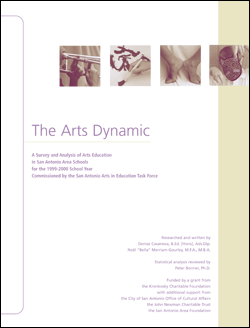Arts Education
Grantmakers in the Arts holds arts education as one of its core funding focus areas. GIA is committed to invigorate funding and support for arts education within federal policy and defend that every resident has access to the arts as part of a well-rounded, life-long education. In 2012, GIA formed the Arts Education Funders Coalition (AEFC), an interest group within GIA, to address identified needs in comprehensive arts education and to strengthen communication and networking among arts education funders. Advised by a committee of Coalition members, GIA engaged the services of Washington, DC-based Penn Hill Group, a firm with education policy expertise and experience working with diverse education groups to research, develop, and promote educational policy strategies.
Most recently, GIA worked with Representative Suzanne Bonamici (D-OR) on the development of the Arts Education for All Act, the broadest arts education policy bill ever introduced in Congress.
In Spring 2021, GIA influenced the U.S. Department of Education to highlight the importance of equitable access to arts and culture to the process of reopening schools and to make explicit how racialized this access was prior to the pandemic and that addressing this inequity is essential to effective reopening.
Grantmakers in the Arts is delighted that in 2020 Congress passed the Supporting Older Americans Act, including our recommendations that the Administration on Aging include the arts in the issues to be identified and addressed and be included among supportive services for older Americans.
GIA has successfully lobbied to include arts-related provisions in the Child Care for Working Families Act, which proposes to better help low-income families pay for childcare and expand high-quality state preschool options.
GIA is extremely proud of our work over the past several years on raising the visibility of the arts in the Elementary and Secondary Education Act (ESEA) in its legislative form. GIA and Penn Hill Group continue these advocacy efforts around the Every Student Succeeds Act (ESSA), guiding GIA members and their grantees in advocating for new or expanded arts programs at their local schools and districts.
2000, 47 pages. Council of Europe Publishing, Cultural Policies Research and Development Unit, (33) 03 88 41 25 81
Read More...Targeted marketing is extremely effective. It uses psychological and purchasing-pattern analysis to divide the population into groups likely to make certain decisions. It then targets those groups with messages that reinforce previous beliefs and, if possible, creates barriers through psychological pressure to stay within certain social, style, and consumption boundaries. The result is a society of many lifestyles, each with boundaries carefully drawn and reinforced.
Read More...2001, 116 pages. San Antonio Arts in Education Task Force, www.saysi.org
Download:
![]() The Arts Dynamic (5Mb)
The Arts Dynamic (5Mb)
Why the fine arts in education are vital
Ramon C. Cortines, executive director of the Pew Network for Standards-Based Reform at Stanford University, comments:
Read More...2003, 79 pages. Department of Art Education, Ohio State University, 128 North Oval Mall, Room 258, Columbus, OH 43210, 614-292-5649
This final report on Transforming Education Through the Arts Challenge (TETAC) is more than a compilation of the results of a five-year initiative to link comprehensive approaches to arts education with national and local school reform efforts.
Read More...The Arts Education Partnership (AEP) held its winter forum on January 26 and 27 in San Francisco. The focus of the meeting was "Critical Issues in Arts Education: Partnering with Philanthropy."
Read More...The theme of education in the arts can be found throughout GIA's programs. The role that the arts can play in education is one of four primary themes that will be explored at our 2002 conference, Creative Connections; and the "Bookmarks" column in this issue of the Reader concentrates on "Arts Education Resources on the Web". The following two articles take a look at recent research, specifically research that explores the connections between education in the arts and student learning in other realms.The theme of education in the arts can be found throughout GIA's programs.
Read More...The Rhode Island Foundation, founded in 1916, is one of the oldest and largest community foundations in the United States. It is also one of a small number of statewide community foundations. In 2000, the Foundation's assets exceeded $400 million. RIF's grantmaking areas are children & families, economic/community development, education, and arts. The arts grantmaking area has several program foci.
Read More... Ralph Waldo Emerson (1802-1882)
We just returned from yet another community gathering where arts leaders sought the support of their business and civic counterparts by documenting the "economic impact" of arts spending and employment in their region.
Read More...
